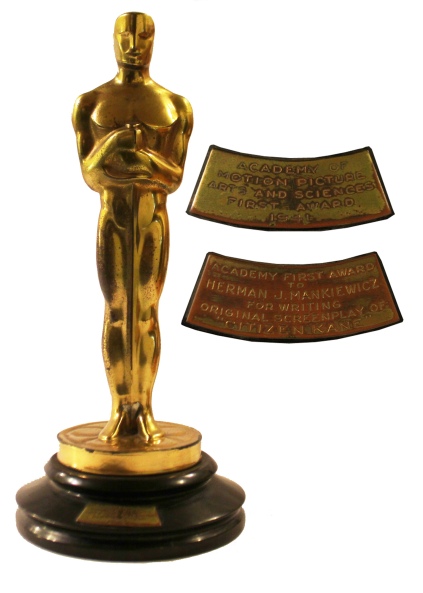 Blog Awards Ireland 2015
Blog Awards Ireland 2015
Web of Notes has been longlisted for Best Education and Science Blog and Best Youth Blog in The Blog Awards Ireland 2015.
 Blog Awards Ireland 2015
Blog Awards Ireland 2015Web of Notes has been longlisted for Best Education and Science Blog and Best Youth Blog in The Blog Awards Ireland 2015.
According to its website, the Academy is “dedicated to the advancement of the arts and sciences of motion pictures.” The 87th Academy Awards will take place on Sunday February 22nd 2015 at the Dolby Theatre in Hollywood, which has a capacity of 3,300 seats on Oscar Night. The Academy Awards are also known as the Oscars.
Officially named the Academy Award of Merit, an Oscar is given in recognition of the highest level of achievement in movie making. (The Academy adopted the nickname ‘Oscar’ in 1939, but no one is quite sure where its name originated – there are a few different theories!)
Although it weighs 8½ lbs, measures 13½ inches high, and has a diameter of 5¼ inches, the Oscar statuette stands tall as the motion picture industry’s greatest honour.

Award for Best Original Screenplay presented to Herman J. Mankiewicz in 1941 for writing Citizen Kane. Image from natedsanders.com.
MGM art director Cedric Gibbons designed the statuette: a knight standing on a reel of film gripping a crusader’s sword. It was modelled after director and actor Emilio Fernandez, who posted nude for the design. George Stanley then sculpted Gibbons’ design.
The five spokes of the film reel represent the original branches of the Academy: actors, directors, producers, technicians, and writers. The original statuettes were gold-plated solid bronze, but in today’s Oscar the bronze has been replaced by gold-plated britannia metal. R.S. Owens and Company manufactures the statuettes in Chicago, who spend 3-4 weeks creating 50 statuettes in preparation for the awards ceremony.
The ‘race’ to be nominated consists of attempts by studios, independent distributors and publicists to make sure that each of the nearly 6,000 voting members of the Academy sees their film. It means special screenings for Academy members, free admission to commercial runs of a film, and the mailing of DVDs.
The Academy aggressively monitors Award campaigning and has issued regulations that limit company mailings to those items that actually assist members in their efforts to assess the artistic and technical merits of a film. This year, an Original Song nomination for ‘Alone Yet Not Alone’ was rescinded when the Academy discovered that the composer emailed 70 members of the Music Branch of the Academy to make them aware of his submission during the nominations voting period – during which information about the composer and lyricist is to remain anonymous. The composer, Bruce Broughton, breached of the Academy’s promotional regulations, the goal of which is to ensure that “the Awards competition is conducted in a fair and ethical manner.” It was the fifth time an Oscar nomination has been rescinded.
Nominations Process
The awards are voted on by members of the Academy of Motion Picture Arts and Sciences. Nomination ballots are mailed to the Academy’s active members in late December. Members from each of the branches vote to determine the nominees in their respective categories – actors nominate actors, film editors nominated film editors, and so on. However, within the Animated Feature Film and Foreign Language Film categories, nominations are selected by vote of multi-branch screening committees. All voting members are eligible to select the Best Picture nominees.
The members fill out the ballot in preferential order (though they are not required to list more than one), and are sent back online (or by mail if requested) to PricewaterhouseCoopers, an international accounting firm, in January. The votes are then counted by hand to prepare a list of nominees. Regular awards are presented for outstanding individual or collective film achievements in up to 25 categories, usually with 5 nominees in each category (up to 10 in the Best Picture category). The nominees are announced each January at the Samuel Goldwyn Theatre, located at the Academy’s Headquarters in Beverly Hills. This year, directors Alfonso Cuarón and J.J. Abrams, Academy President Cheryl Boone Isaacs, and actor Chris Pine announced the nominations on Thursday, 15th January 2015.
Final Balloting Process
Final ballots are delivered to voting members in late-January and are due back to PricewaterhouseCoopers the Tuesday prior to Oscar Sunday for final tabulation.
The Academy’s entire active membership is eligible to select Oscar winners in all categories, although in five – Animated Short Film, Live Action Short Film, Documentary Feature, Documentary Short Subject, and Foreign Language Film – members can vote only after attesting they have seen all of the nominated films in those categories.
For all the other awards the winner is the person or film with the most votes, but the winner for Best Picture is the first film to get over 50% of the votes. Like in the system that is used in the nominations, voters rank their choices in preferential order and the films are then eliminated in the same manner that is used for the nominations. Each movie gets its own pile — the film that appears most frequently as a first-place choice will have the largest stack, the movie with the next-most first-place votes will have the second-largest, and so forth. Then each stack is counted.
If one nominee garners more than 50% of the first place votes, it will win Best Picture. If, as is more likely, no nominee reaches this threshold, the tabulators go to the smallest stack remaining, eliminate that movie, remove that stack and go down those ballots to voters’ next-highest choice (of a movie that’s still in the running, of course) and redistribute the ballots across the piles once again. This process of elimination and reapportion continues until one film reaches at least 50% + one vote.
After final ballots are tabulated, only two partners of PricewaterhouseCoopers know the results until the famous envelopes are opened on stage during the Academy Awards presentation. If a wrong name were to be called, it would be immediately corrected by one of the partners, who would go to the microphone and announce the actual winner.
The awards honour achievements in cinema from the previous year (2014), from on-screen actors to everyone behind-the-scenes. These are the categories:
Best Picture
Actor in a Leading Role
Actress in a Leading Role
Actor in a Supporting Role
Actress in a Supporting Role
Animated Feature Film
Cinematography
Costume Design
Directing
Documentary Feature
Documentary Short Subject
Film Editing
Foreign Language Film
Makeup and Hairstyling
Music (Original Score)
Music (Original Song)
Production Design
Short Film (Animated)
Short Film (Live Action)
Sound Editing
Sound Mixing
Visual Effects
Writing (Adapted Screenplay)
Writing (Original Screenplay)
One of the most anticipated and exciting parts of the show is watching the stars arrive at the ceremony and walk down the Red Carpet. People watching at home want to see which stars are attending the event, what they’re wearing, and who they’re with. Most men attending the Oscars wear a tuxedo, and women wear extravagant, elegant dresses. The Red Carpet at the Dolby Theatre is 500 feet long, and is flanked by 700 fan bleacher seats which are allocated through an online global lottery. There are several TV shows and live online reports that show you what’s happening on the red carpet. Check out the printable ‘Red Carpet Bingo’ at the end of this post!
Sometimes you will also see or hear the expression ‘Oscar buzz.’ Here, buzz means ‘what people are talking about.’ Oscar buzz simply means ‘what people are saying about the Oscars’ – who will win, what film will win, etc. On Twitter, #Oscars is used.
Far from the eagerly anticipated and globally televised event it is today, the first Academy Awards ceremony took place out of the public eye during an Academy banquet at the Hollywood Roosevelt Hotel. Two hundred seventy people attended the May 16, 1929 dinner in the hotel’s Blossom Room; guest tickets cost $5. The first recipient of the statuette was Emil Jannings, who was named Best Actor for his performance in The Last Command and The Way of All Flesh. However, there was little suspense when the awards were presented that night, as the recipients had already been announced three months earlier.
That all changed the following year, however, when the Academy kept the results secret until the ceremony but gave a list in advance to newspapers for publication at 11 pm on the night of the Awards. This policy continued until 1940 when, much to the Academy’s surprise, the Los Angeles Times broke the embargo and published the names of the winners in its evening edition – which was readily available to guests arriving for the ceremony. That prompted the Academy in 1941 to adopt the sealed-envelope system still in use today. Since 2011, Marc Friedland has designed the envelopes and announcement cards bearing the names of each Oscar recipient.
The making of the envelope
The host of this year’s show is Neil Patrick Harris.
Each award is handed out by a presenter. The presenter is usually another actor. They announce the category and usually say, “And the nominees are…” The presenter will then read the names of the nominees from the Teleprompter.
There is also an In Memoriam segment which honours those who died during the previous year. A committee made up from the Academy weigh in a lot of factors when deciding on who features in the tribute – in particular, their contribution to and achievements in the film industry. The list is passed on to the producers who then commission the commemorative reel. Last year the tribute was presented by Glenn Close, followed by a performance by Bette Midler.
http://www.dailymotion.com/video/x1ebgeh_oscars-2014-in-memoriam_creation
Once the presenter has finished announcing the nominees, he/she then says, “And the Oscar goes to…” or “And the Academy Award goes to…” and opens the envelope to read the name of the winner. The envelope is sealed so that no one knows the winner until that moment! (Only two partners of PricewaterhouseCoopers know the results beforehand.) The winner then comes to the stage to accept his/her award and make a short acceptance speech.
The final award of the night is always Best Picture.
http://oscar.go.com/photos/presenters-87th-oscars-2015/
http://marcfriedlandinc.com/TheOscarsRedCarpetBingo.pdf
Click here for your online ballot! (Here for printable ballot.)
Film Poster Analysis, Film Revision: Key Words
Sources used in composing this guide: oscars.org, oscar.go.com, englishteachermelanie.com, latimes.com, ew.com.
Images: natedsanders.com, Mashable.com.
As part of European Schoolnet Academy’s Games in Schools course I created this ‘Learning Design’ which revolves around the online PBS game In Search of Shakespeare.
In this scheme, students revise their knowledge of Shakespeare’s life, the theatre, letter writing, and article writing.
Developed by the London Institute of Education, the Learning Designer is essentially an online tool to help create a lesson plan or scheme of lessons through a series of teaching and learning activities (TLAs). One of its useful features is the pie chart which shows how the time is divided in the lesson to the different types of activities (categorised as Acquisition, Collaboration, Discussion, Inquiry, Practice, and Production).
More information on the Learning Designer is available here on IOE’s website and on the project’s website.
 Edublog Awards 2014
Edublog Awards 2014Web of Notes is a finalist for Best Educational Use of Media in The Edublog Awards 2014.
To vote, visit this page (or the List.ly page here) and press the like button beside ‘Web of Notes’.
Thank you so much for your support!
A game I created with Scratch to test some knowledge of characters in the novel. Click the image below to open the game.
MadelineMiller.com: The ‘find out more’ section includes character glossaries, a reader’s guide, a slideshow and commentary about the author’s trip to Troy, and essays.
‘Q&A with Madeline Miller‘, MadelineMiller.com.
‘Live webchat with Madeline Miller’, The Guardian, 30 August 2013.
‘The Song of Achilles’, UCL (Department of Greek and Latin), 24th November 2012.
‘The Saturday interview: Madeline Miller, Orange prize winner’, The Guardian, 22 June 2012.
‘An Old Song with a New Melody: An Interview with Madeline Miller’, Ancient History et cetera, 21 June 2012.
‘Paperback Q&A: Madeline Miller on The Song of Achilles’, The Guardian, 1 May 2012.
‘Gregory Maguire interviews Madeline Miller!’, HarperCollins Library, 22 December 2011.
‘Interview with Madeline Miller’, roarings20s, 14 December 2011.
‘I would like to hear Achilles sing‘, Histo-Couch, 7 December 2011.
Book trailer.
Miller speaking about the novel.
Part one of Miller's reading and Q&A as part of the Summer Reading Presentation at Wentworth Institute of Technology on 9 October 2014.
Part two of Miller's reading and Q&A as part of the Summer Reading Presentation at Wentworth Institute of Technology on 9 October 2014.
Miller reading from and discussing the novel at The Center of Fiction on 23 October 2012.
Madeline Miller and Gregory Maguire talk about the novel.
Staged production produced by the Newton Theatre Company in March 2014. Part One: Before Troy.
Staged production produced by the Newton Theatre Company in September 2014. Part Two: Troy.
You must be logged in to post a comment.